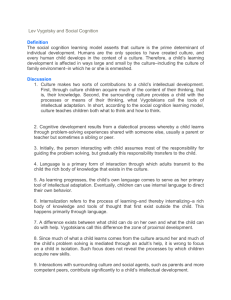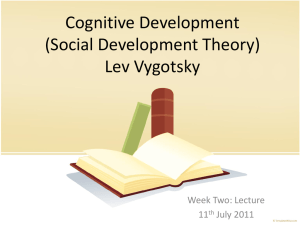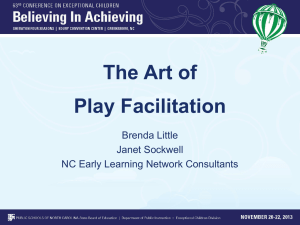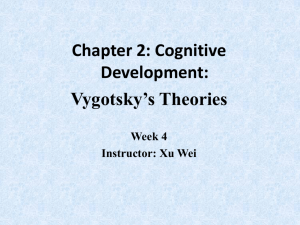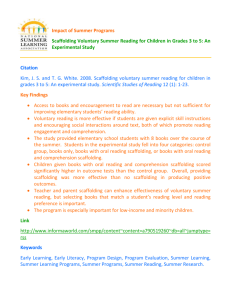Vygotsky Scaffolding
advertisement
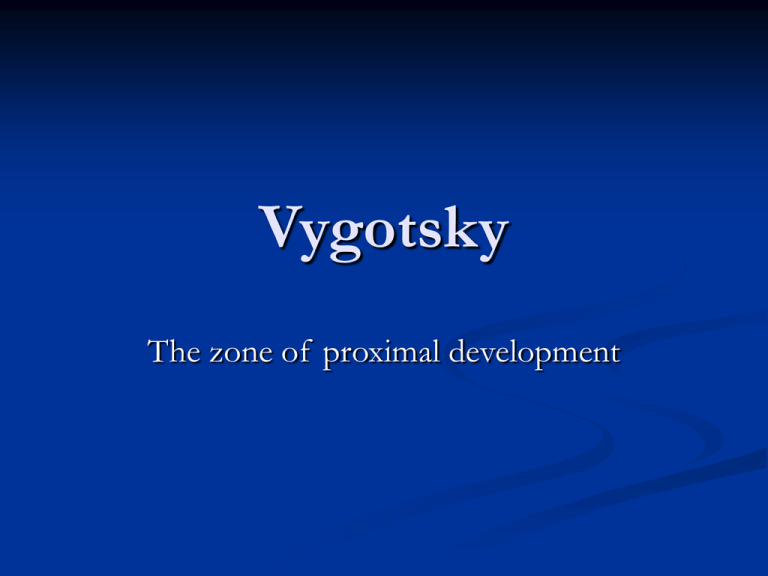
Vygotsky The zone of proximal development The ZPD This was a term used by Vygotsky to refer to the distance between what a child can achieve alone, and what the same child can achieve with guidance from another person. According to Vygotsky (1978), ‘..what is the zone of proximal development today will be the actual development level tomorrow.’ By this he meant what a child needs help with today, he or she will be able to do independently tomorrow. The word ‘proximal’ means next or close. A child being assisted to perform a task in his or her zone of proximal development is close to managing it alone; it will be the next thing they are able to achieve independently. Hedegaard (1996) Aim Hedegaard investigated a teaching method which involved deliberately working within the zone of proximal development in a whole class situation. Method A special programme of instruction was used with Danish primary school children in a longitudinal study. The three interrelated topics were evolution of species, the origin of human beings and historical change in societies. These topics were presented separately through a range of learning and research activities, including the following: shared concentrate activities; whole-class discussion; group work and collective problem solving. Although the topics were presented separately, children had to answer questions that required an integrated understanding of the three areas. Results The children were successfully able to answer the questions. They could identify problems and solutions and shifted from an interest in particular species (concrete) to the formulation of theories and models of species adaptation (general). Fast learners found the new approach to learning stimulating, whilst less able children also showed interest and motivation. Conclusion By carefully structuring class activities teachers can successfully work with the zone of proximal development in a whole class teaching environment. Scaffolding Vygotsky emphasised the role of adult intervention and assistance in the development of cognition. One such intervention that reflects this is scaffolding (Wood et al, 1976). This support is temporary, in that parents who are sensitive to the needs and abilities of a child gradually give less support as a child gains a particular skill, up to the point that the child can perform the skill independently. Example A grandfather is reading a story to his granddaughter. He pauses and directs the child’s attention to a picture, saying ’Can you point to the sheep?’ this supports the child’s growing ability to relate the words of the story to visible features of the pictures. Study Aim Wood and Middleton (1975) investigated the type of parental assistance offered in a block building activity. Method The interactions between children (aged 4 years) and their parents were observed. Each was allowed to play individually with a set of wooden blocks with a parent looking on. The task, which involved fitting them all together, was purposely too difficult for the child to complete alone. Results Initially parents showed their child how to assemble the blocks, and then, as the child became more capable of managing alone, the parent would stop helping directly but still give verbal suggestions and encouragement. Various levels of support were noted: Demonstration, Preparation, Indication, Specific Instruction and Verbal Prompt. The level of assistance declined as the activity progressed. Evaluation Wood and Middleton showed that as the child becomes more skilled they are given less specific support. This finding supports the notion of scaffolding. The study involves the acquisition of a single specific skill rather than general cognitive development. Theories of cognitive development are really about explaining how children acquire conceptual rather than routine task specific knowledge. Scaffolding appears in many different forms. Parents will use scaffolding in their responses to a child’s early attempts at speech and in helping children to understand their feelings, ‘You’re a bit upset now, aren’t you?’ Nursery teachers will provide scaffolding for young children as they are introduced to formal learning activities….. etc.
